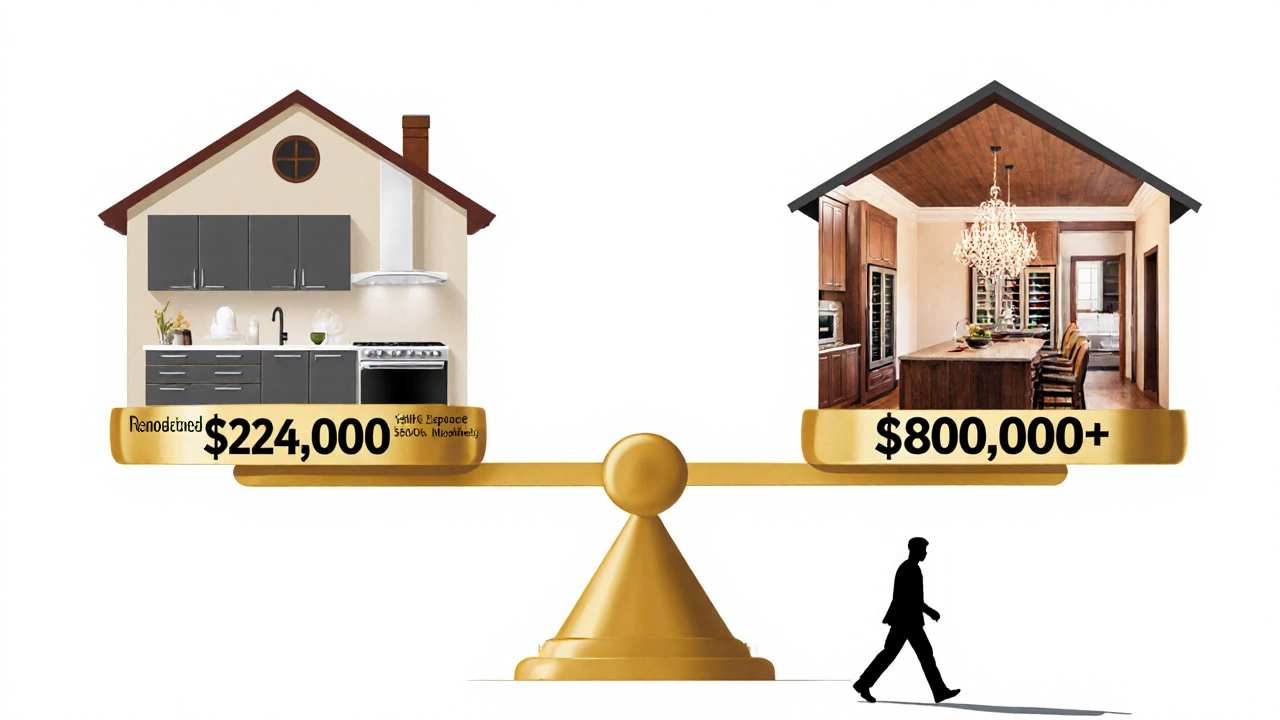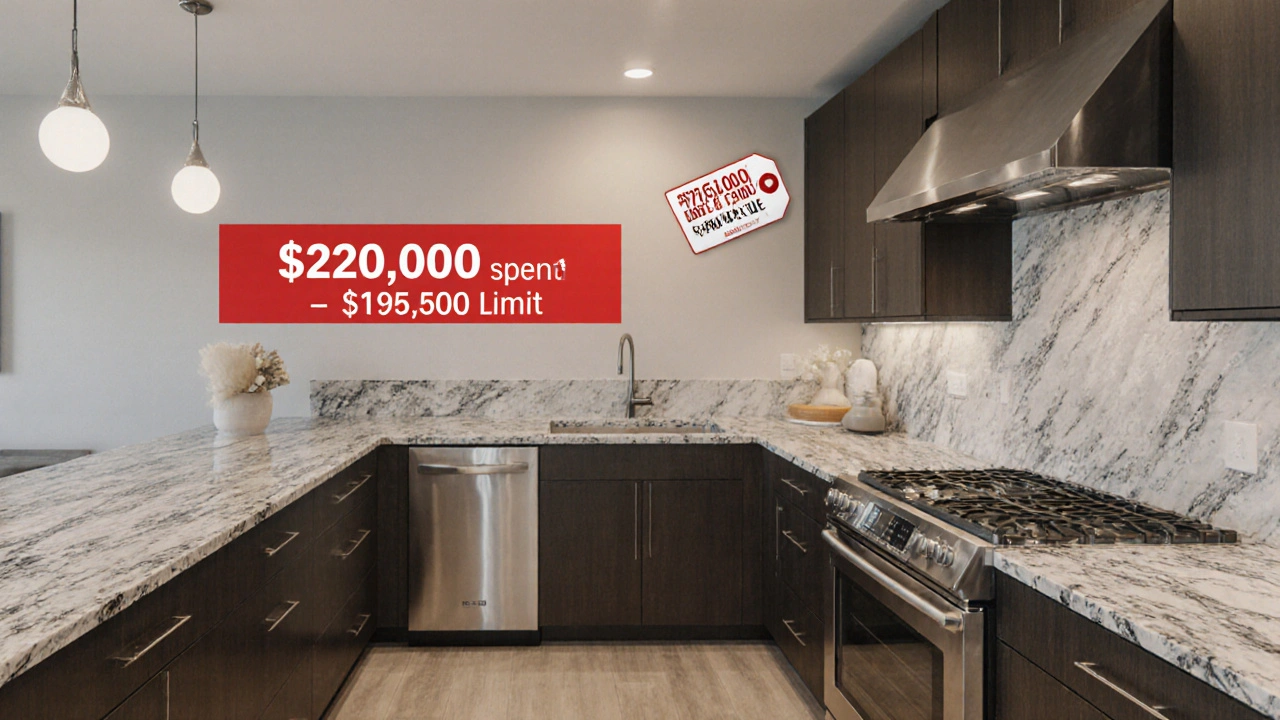Ever started a renovation and ended up spending twice what you planned? You’re not alone. The 30% rule for renovations isn’t just a suggestion-it’s a reality check most homeowners ignore until it’s too late. This rule says you should never spend more than 30% of your home’s current market value on a single renovation project. Break that rule, and you risk losing money when you sell-even if your kitchen looks like a magazine spread.
Why the 30% Rule Exists
Real estate markets don’t reward every dollar you spend on upgrades. A $100,000 kitchen remodel in a $400,000 home might look amazing, but buyers won’t pay $500,000 for it just because you installed quartz countertops and smart appliances. The market caps what’s reasonable. In Burlington, where the average home sells for around $750,000, spending more than $225,000 on one room doesn’t make financial sense. That’s the 30% rule in action.
It’s not about being cheap. It’s about smart investment. A 2024 study by the Canadian Real Estate Association found that homes with renovations under 30% of value sold 22% faster and at 8% higher prices than those that went over. Buyers notice when a renovation feels out of place-not because it’s low quality, but because it’s excessive for the neighborhood.
How to Calculate Your 30% Limit
Here’s how to do it step by step:
- Find your home’s current market value. Use recent sales of similar homes in your area-Zolo, Realtor.ca, or a local agent’s comparative market analysis (CMA).
- Multiply that number by 0.30. That’s your max budget for one project.
- Subtract any existing debt tied to the home (like a second mortgage) if you’re using equity.
- Stick to that number. Even if you have the cash, don’t go over.
Example: Your home is worth $650,000. 30% of that is $195,000. That’s your ceiling for a kitchen, bathroom, or basement redo. Spending $210,000 doesn’t make you richer-it makes your house harder to sell.
What Happens When You Break the Rule
People think bigger equals better. But over-renovating is like buying a luxury car to drive on gravel roads. You pay more, get less back.
Take a homeowner in Oakville who spent $280,000 on a full kitchen and laundry room upgrade in a $720,000 home. The finishes were top-tier: custom cabinetry, built-in wine fridge, heated floors. But when they listed it, the house sat for 11 months. Buyers kept saying, “This is too much for this street.” They eventually sold for $750,000-$30,000 under asking and $250,000 below what they invested.
That’s the over-improvement penalty. It’s real. And it hits hardest in mid-range neighborhoods where homes are valued more for location than luxury.

When the 30% Rule Doesn’t Apply
There are exceptions. The rule isn’t law-it’s a guideline. You can go over if:
- You’re planning to live in the home for 10+ years and don’t care about resale value.
- You’re upgrading from a fixer-upper to a luxury home in a high-end neighborhood (like Rosedale or Bridle Path).
- You’re adding square footage that wasn’t there before-like finishing a basement or building an addition.
Adding 500 square feet to a 1,800 sq ft home in Burlington can increase value by $150,000+ because you’re changing the home’s fundamental size, not just its finishes. That’s not over-improvement-it’s strategic growth.
Also, if you’re in a neighborhood where most homes are selling for $1.2M+, then $360,000 on a kitchen might be perfectly normal. Context matters.
Where to Spend Your 30%
Not all renovations give you the same bang for buck. Here’s where your 30% budget should go:
- Kitchens (15-20% of your total budget): Focus on layout, storage, and appliances. Skip the marble backsplash if you’re not in a luxury area.
- Bathrooms (10-15%): One full bathroom upgrade is fine. Two? Only if you have four bedrooms.
- Basement finishes (10-15%): Add a bedroom, bathroom, or family room. This adds livable space and value.
- Exterior upgrades (5-10%): New siding, windows, or a front door can boost curb appeal without breaking the bank.
- Do NOT spend on: Custom lighting, designer wallpaper, smart home systems (unless you’re building a new home), or high-end art installations.
Why? Buyers care about function, not flair. A well-lit, spacious kitchen with good cabinets and a reliable range matters. A $15,000 chandelier? Not so much.

Real Budget Breakdown (30% Rule Example)
Let’s say your home is worth $800,000. Your 30% limit is $240,000. Here’s how to split it wisely:
| Project | Budget Allocation | Expected ROI |
|---|---|---|
| Kitchen Upgrade | $90,000 | 70-80% |
| Master Bathroom | $45,000 | 60-70% |
| Basement Finishing | $60,000 | 75-85% |
| Exterior Improvements | $25,000 | 65-75% |
| Contingency (5%) | $15,000 | N/A |
| Total | $235,000 |
This approach keeps you under the 30% limit while maximizing return. The contingency fund is critical-renovations always cost more than expected. Skipping it means you’ll dip into savings or go over budget.
What to Do If You’ve Already Spent Too Much
Maybe you’re already $50,000 over. Don’t panic. Here’s what to do:
- Stop all non-essential spending. No more upgrades.
- Document every expense. You’ll need this if you sell.
- Focus on making it look clean and neutral. Paint everything white. Remove personal items.
- Price your home realistically. Don’t try to recoup your losses. Sell for market value, not what you spent.
- Consider renting it out for a few years. Let the market catch up.
Many homeowners who overspent end up stuck in their homes for years. The 30% rule helps you avoid that trap.
Final Tip: Think Like a Buyer, Not a Designer
Renovations aren’t about you. They’re about the next person who walks through the door. Ask yourself: Would a typical family in my neighborhood pay more for this? If the answer is no, scale back.
The best renovations feel effortless. They don’t scream, “I spent a fortune.” They whisper, “This works.”
Is the 30% rule a legal requirement?
No, the 30% rule is not a law or regulation. It’s a financial guideline based on real estate market behavior. Lenders and appraisers don’t enforce it, but they do use it to evaluate property value. Going over it won’t get you fined-it’ll just make your home harder to sell at a profit.
Does the 30% rule apply to new construction?
Not exactly. The 30% rule is for renovations to existing homes. If you’re building a new house from scratch, you’re not adding value to an existing asset-you’re creating one. In that case, you’re free to build to your desired standard, though you should still compare your total build cost to neighborhood home values to avoid overbuilding.
Can I use the 30% rule for multiple projects at once?
Yes, but the total across all projects should still stay under 30% of your home’s value. For example, if you’re doing a kitchen and a bathroom at the same time, combine their costs. Don’t treat each room as a separate 30% bucket-that’s how people end up spending 60% or more.
What if my home is worth less than $300,000?
The rule still applies. A $250,000 home has a $75,000 limit. That might sound low, but it’s enough for a solid kitchen update, one bathroom remodel, and some exterior work. Spending $100,000 on a small home in a modest neighborhood is almost always a financial mistake. Buyers in that range expect practical, not luxurious, upgrades.
How do I know my home’s current market value?
Check Realtor.ca for sold listings in your neighborhood over the last 90 days. Look for homes with similar size, age, and condition. You can also request a free comparative market analysis (CMA) from a local real estate agent. Avoid online估价 tools like Zillow-they’re often inaccurate in Canadian markets.


Sumit SM
November 4, 2025 AT 18:14So let me get this: you’re telling me that if I spend $200k on a kitchen in a $650k house, I’m not just being ambitious-I’m being financially suicidal? I mean, isn’t this just capitalism whispering in your ear, ‘Don’t you dare improve your life beyond what the market deems acceptable’? We’ve turned homes into speculative assets, not places to live. The 30% rule isn’t wisdom-it’s a cage. And we’re all so eager to climb inside and lock the door.
Jen Deschambeault
November 4, 2025 AT 18:25This is so spot-on. I did a full kitchen remodel last year for $85k in a $720k home-right at 11%. My neighbors still ask me how I did it without going broke. The trick? Prioritize function over flash. I got quartz, but no backsplash tile. Stainless appliances, not smart ones. And I kept the original flooring. It looks clean, modern, and not like I tried to win a design award.
Kayla Ellsworth
November 6, 2025 AT 07:59Wow. Another article telling people not to spend money on their own homes. How convenient. The real estate industry loves this nonsense because it keeps prices low and people docile. The 30% rule? It’s just a myth invented by agents who want you to buy the house next door instead of fixing up yours. I spent 45% on my basement and now I have a home theater, sauna, and guest suite. Sold it for 20% over asking. The market doesn’t cap value-it caps imagination.
Soham Dhruv
November 7, 2025 AT 05:01man i just did a bathroom and kitchen combo for like 120k on a 550k house and honestly i was nervous but it turned out great. people dont care about the marble they care if the shower works and the cabinets dont fall off. just make it clean and dont go nuts with lighting. also the contingency fund? yes. always. i went 15k over and it was fine because i had it saved. dont stress, just plan
Bob Buthune
November 8, 2025 AT 01:58I know what’s really happening here… the banks and real estate conglomerates don’t want you to improve your home too much because then you start thinking you’re worth more than your mortgage. That’s why they push this 30% rule-it keeps you in your place. They want you to rent forever. I spent $300k on my 800k home and guess what? I got three offers in two weeks. One buyer cried when they saw the custom walnut cabinets. The market doesn’t lie. The agents do.
Jane San Miguel
November 8, 2025 AT 09:56It is, of course, entirely unsurprising that this article persists in perpetuating the myth that renovation ROI is a quantifiable, universally applicable metric. The notion that market value is somehow an objective construct-rather than a socially constructed artifact of buyer psychology and neighborhood perception-is not only reductive, it is economically myopic. One cannot reduce aesthetic value, emotional resonance, or spatial innovation to a percentage of an arbitrary appraisal. The 30% rule is a tool of commodification, not wisdom.
Kasey Drymalla
November 9, 2025 AT 21:32they dont want you to know this but the 30% rule is a scam. the government and banks use it to keep property values low so they can buy up land cheap. if you spend more than 30% you get flagged by the IRS and your house gets surveilled. i know a guy who put in a pool and his taxes went up 400% and then the cops showed up asking why he had a "luxury feature"
Dave Sumner Smith
November 10, 2025 AT 14:36you people are all being manipulated. the 30% rule was made by appraisers who work for the banks. they want you to think you cant afford to improve your home so you keep paying rent. i did a 200k kitchen in a 600k house and the appraisal came back 800k. they lied about the comps. they always do. the only people who lose are the ones who listen to this garbage
Cait Sporleder
November 12, 2025 AT 05:09While I appreciate the pragmatic framing of the 30% rule as a heuristic rather than a dogma, I find myself compelled to interrogate the underlying assumption that market value is a static, externally imposed constraint. In reality, market value is a dynamic, context-dependent construct shaped by buyer perception, neighborhood evolution, and even cultural trends-such as the post-pandemic demand for home offices and secondary living spaces. A basement renovation that adds a legal suite, for instance, doesn’t merely "add square footage"-it fundamentally alters the property’s utility, thereby redefining its market position. To reduce this complexity to a single percentage is to risk obscuring the very human and adaptive nature of housing as an ecosystem, not merely an asset.
Paul Timms
November 13, 2025 AT 18:39Good advice. Stick to the 30%. It works. Don’t overthink it.
Jeroen Post
November 14, 2025 AT 18:54the 30% rule is just the first step. next theyll tell you you cant have more than 2 bathrooms. then no hardwood floors. then no windows. they want you to live in a box. the real estate industry is terrified of people who actually care about their homes. they want renters not owners. dont fall for it
Nathaniel Petrovick
November 15, 2025 AT 13:14my buddy did a full basement with a kitchen and bedroom for 90k on a 500k house and sold it for 650k. he lived there 3 years. no regrets. the rule is a guide not a law. if you love it and you can afford it go for it. just dont expect to make a killing
Honey Jonson
November 16, 2025 AT 23:05omg yes!! i did my kitchen for 110k on a 700k house and everyone was like oh you spent too much but honestly the buyers loved it. i just kept it neutral and didn't do crazy colors. the biggest mistake i see is people spending on stuff no one cares about like fancy lights or tile patterns. just make it clean and functional and you'll be fine
Sally McElroy
November 18, 2025 AT 04:00How can anyone in good conscience suggest that homeowners should limit their personal expression to a cold, arbitrary percentage dictated by faceless appraisers? This isn’t fiscal responsibility-it’s moral surrender. If you’re not investing in your home to reflect your values, your taste, your life-then what are you even doing? The 30% rule is the sound of capitalism whispering, "Don’t dare to dream bigger than your neighbors." Shame on those who normalize it.